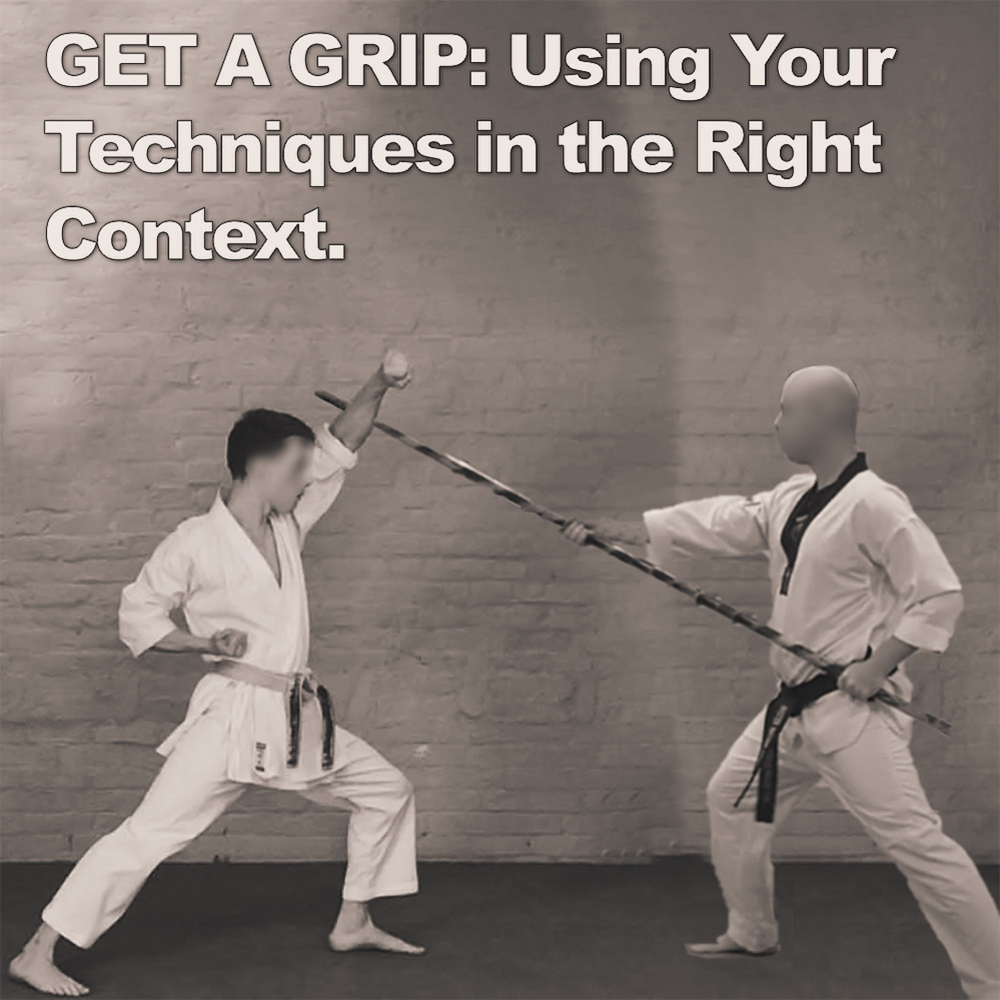
GET A GRIP: Using Your Techniques in the Right Context.
Posted by ADAM CARTER on SEP 03, 2024

GET A GRIP: Using Your Techniques in the Right Context.
(Approx 2 minute 45 second read)
Throughout all of the martial arts and styles that exist, they were all created to make use of biomechanics and the weaknesses of human anatomy. Where the various arts differ is in the rules, the goals, and the context that they are trained for.
In competitions, or even street fights, the objective is to win. These are consensual fights where you actively seek engagement – you have agreed to fight.
In self-defense, the goal is to end a dangerous situation as quickly as possible. The fight, if it cannot be avoided, is not consensual – you do ‘not’ agree to fight. The primary goal here is survival and escape.
While there are common techniques, the goals and objectives are vastly different, necessitating different tactics. This also means there are methods and techniques that you consistently train in that may not apply universally.
If we go back in time, every technique was originally created to solve a real-world self-defense problem. If a technique worked, it was because it was found to have advantages in its application. If a technique didn’t solve a problem, it was discarded.
Fast forward to today, where sport often seems to be the highest priority for many practitioners. Early in your training, the positions and techniques you learn are likely simple and favorable for winning. Your hands may be held in a guard, aware of the threat, waiting in a stance – ready to fight.
If your assumption is that everything is about punching, kicking, ‘blocking,’ and consensual fighting, then learning may end there. Unfortunately, this is where many practitioners stop; it’s all they see.
But many of the techniques that you believe are only for punching, kicking, and ‘blocking’ may fail in a non-consensual situation because they were not created to work in the context you’ve tried to use them in.
Sometimes, a motion will have several related applications that differ in context yet still use the same mechanics. The motion is the same, but the emphasis is different.
Understanding the context in which a technique was designed to be used is crucial.
Not every technique will work in every situation, and not every situation will allow you to use techniques the way you’ve trained them in a controlled environment. The key is to adapt and understand that true knowledge lies in your ability to discern when and how to apply what you’ve learned.
As an example, I once witnessed a well-known instructor from Okinawa, with impeccable lineage, demonstrate an application from a kata. He used a ‘Jodan Age Uke’ to block a ‘bo’ (six-foot staff) with his forearm.
As a retired EMT, I know the forearm contains two long, relatively thin bones (the ulna and radius). Fractures of these bones are some of the most common injuries. No matter how well-conditioned they are, the force of a bo strike, often made of solid oak, would easily cause fractures.
This is an example of using a technique, in this case, the ‘upper rising block’, in the wrong context. The motion is correct, but the emphasis is vastly wrong.
In Okinawan karate, there is something called the ‘double bone block’, which distributes the force of impact between two bones, allowing them to absorb the full force of the blow. But even then, common sense and context must rule.
If you take a single movement and strip away its label – its name – you’ll find there are nearly limitless ways to adapt, vary, and explore that movement.
But to truly understand this, you must step outside your lineage, your style, for a moment and grasp how much context matters.
To grow as a martial artist, you must look beyond the surface and recognize that context shapes effectiveness. Train with awareness, question assumptions, and never stop seeking a deeper understanding. It isn’t just about the techniques – it’s about having the wisdom to apply the correct ones when it matters most.
Written by AC.
![]() Photo Credit: Image is a composition for illustrative purposes only.
Photo Credit: Image is a composition for illustrative purposes only.
